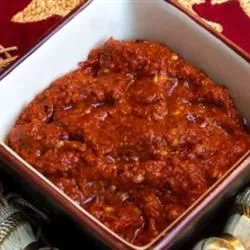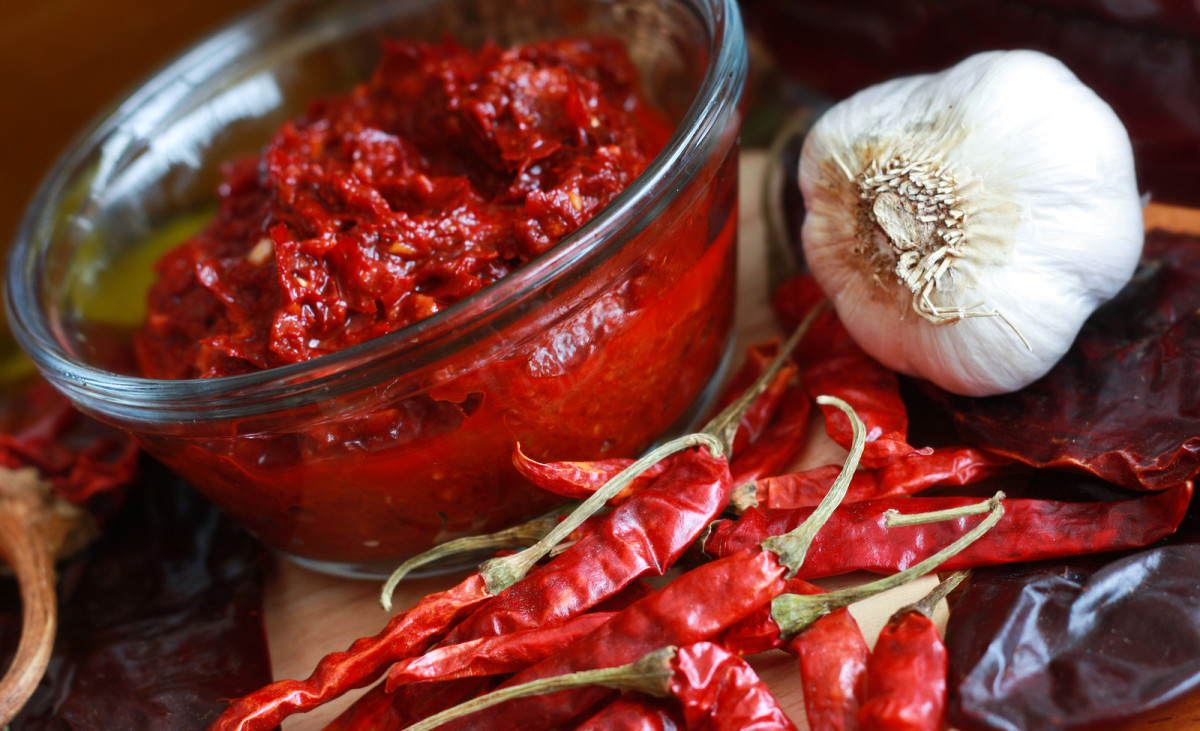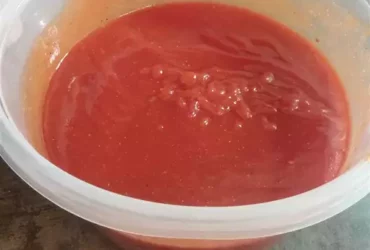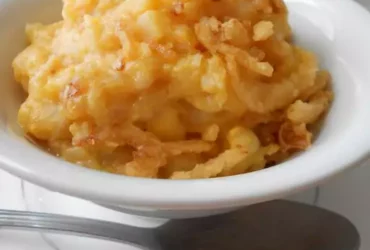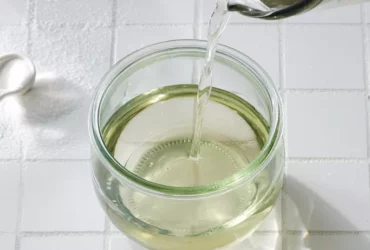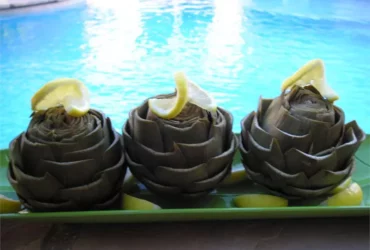Ingredients
Tunisian Staples
Tunisian cuisine is a blend of African, Arab, and Mediterranean flavors, with ingredients playing a crucial role in defining its unique character. In this context, the ingredients used in Tunisian dishes are not only delicious but also reflect the country’s rich cultural heritage.
At the heart of Tunisian cooking lies a staple spice blend called ras el hanout, which roughly translates to “the head of the shop.” This aromatic mixture typically includes cumin, coriander, cinnamon, ginger, cardamom, and cloves, among other spices. Ras el hanout adds depth and warmth to a wide range of Tunisian dishes, from couscous and stews to sauces and marinades.
Another fundamental ingredient in Tunisian cuisine is olives. Green and black olives are widely used in the country’s cooking, particularly in salads, stews, and as a topping for bread. Tunisia is home to numerous olive varieties, including the popular Chemlali and Picholine.
Couscous, a traditional North African dish made from crushed durum wheat semolina, is a staple in Tunisian households. This comforting meal typically consists of steamed couscous topped with vegetables, meat (usually lamb or chicken), and sauces. Couscoussiers are often used to cook the couscous, which is then served with various accompaniments like preserved lemons, harissa, and olive oil.
Preserved lemons, also known as pickled lemons, are a common ingredient in Tunisian cuisine. These tangy condiments add a burst of citrus flavor to numerous dishes, including stews, salads, and sauces. Preserved lemons are typically made with sliced or chunked lemons that have been cured in salt and spices.
Tunisian harissa, the star ingredient of this recipe, is a spicy chili paste made from roasted red peppers, garlic, coriander seeds, caraway seeds, and olive oil. Harissa is a fundamental condiment in Tunisian cuisine, used to add heat and flavor to various dishes, from couscous and stews to sauces and marinades.
Other essential ingredients in Tunisian cooking include chickpeas, which are often used in stews and salads; preserved vegetables like eggplant and bell peppers, which are pickled in oil or salt; and fresh herbs like parsley, cilantro, and mint, which add a fragrant touch to numerous dishes.
The rich flavors of Tunisian cuisine can be attributed, in large part, to the country’s strategic location between Africa, Europe, and the Middle East. The blending of influences from these regions has resulted in a unique culinary identity that is characterized by bold flavors, aromatic spices, and a deep appreciation for tradition.
The key to making great Tunisian harissa is in the ingredients you use. While many recipes may suggest shortcuts or substitutions, we’ll be focusing on using fresh and traditional ingredients that will give your harissa a deep and authentic flavor.
First, let’s talk about the chili peppers. For authentic Tunisian harissa, you want to use hot red chilies known as “sharrar” or “krimi.” These chilies are small, bright red, and have a distinctive pointed tip. If you can’t find these specific chilies in your local market, you can substitute with other hot red peppers like cayenne or habanero.
The next ingredient is garlic. Tunisian harissa typically uses about 4-6 cloves of garlic per recipe, so be sure to have some on hand. You want to use fresh garlic for the best flavor, so try to avoid pre-minced or powdered garlic.
Cumin seeds are another essential ingredient in Tunisian harissa. These small, round seeds add a warm, earthy flavor to the dish that complements the chilies perfectly. Be sure to toast your cumin seeds before grinding them, as this will bring out their full flavor and aroma.
Tunisian harissa also includes coriander seeds, which have a slightly sweet and citrusy flavor. Like cumin seeds, these should be toasted before grinding to release their oils and intensify their flavor.
Caraway seeds are another common ingredient in Tunisian cuisine, particularly when used in combination with cumin and coriander. They have a nutty, slightly bitter flavor that pairs well with the chilies and spices.
Paprika is another essential ingredient in this recipe. You’ll want to use the smoked variety for its rich, smoky flavor. If you can’t find smoked paprika, you can substitute with regular paprika or even chili powder.
Salt, of course, is a crucial element in any recipe. Be sure to use kosher salt or sea salt, as these have a coarser texture and cleaner flavor than table salt.
Finally, for the oil, we’ll be using olive oil exclusively in this recipe. You want to choose a high-quality olive oil with a mild flavor that won’t overpower the other ingredients. Look for an extra-virgin or cold-pressed oil for the best flavor and nutrition.
In terms of specific quantities, you can adjust these based on your personal preferences and how spicy you like your harissa. However, here’s a general guideline to get you started:
23 dried red chilies or red pepper flakes, depending on desired heat level
The ingredients for making a authentic Tunisian Harissa recipe typically include dried red chilies or red pepper flakes, which serve as the foundation for this spicy condiment.
Dried red chilies are preferred in traditional Tunisian recipes because they offer a more intense and complex heat flavor compared to red pepper flakes.
Red pepper flakes, on the other hand, provide a milder and slightly sweeter heat level, making them an excellent option for those who prefer a less intense harissa.
The ideal number of dried red chilies or amount of red pepper flakes required can vary depending on individual preferences for heat level in the harissa.
For a mild version of the harissa, using 6-8 dried red chilies or approximately 1/2 teaspoon of red pepper flakes may be sufficient.
In contrast, those who prefer a medium to hot harissa can use around 10-12 dried red chilies or about 3/4 teaspoon of red pepper flakes.
For an extremely spicy and intense version of the harissa, using all 23 dried red chilies or approximately 1-2 teaspoons of red pepper flakes is recommended.
The key to achieving a perfectly balanced and aromatic harissa is to carefully toast the dried red chilies over low heat, then grind them into a fine paste before mixing with olive oil, garlic, coriander seeds, caraway seeds, salt, and any other desired spices or ingredients.
1 teaspoon ground coriander
Coriander, also known as Cilantro, is a crucial ingredient in many North African and Middle Eastern cuisines, including the Tunisian Harissa Recipe.
Ground coriander, specifically 1 teaspoon of it, plays a pivotal role in adding depth and warmth to the sauce. The seed pods of the coriander plant are harvested, dried, and then ground into a fine powder, which is used to add aroma and flavor to various dishes.
The earthy, nutty taste of ground coriander complements the bold flavors of the Harissa sauce, balancing out the heat from the chili peppers. In traditional Tunisian cuisine, coriander is often used in combination with other spices like cumin and caraway seeds to create a distinctive flavor profile.
The use of 1 teaspoon of ground coriander in the Tunisian Harissa Recipe may seem like a small amount, but it packs a significant punch. The spice enhances the overall complexity of the sauce and adds a subtle warmth that lingers on the palate. If you’re looking to experiment with different flavor combinations, consider substituting or adjusting the amount of ground coriander to suit your taste preferences.
In addition to its culinary uses, coriander has been prized for its medicinal properties in traditional medicine. The essential oil extracted from the plant is said to possess anti-inflammatory and antibacterial properties, making it a popular ingredient in natural remedies.
When working with ground coriander, it’s essential to store it properly to maintain its flavor and aroma. Keep the spice in an air-tight container, away from direct sunlight and moisture. This will ensure that the coriander retains its potency and stays fresh for a longer period.
1 teaspoon caraway seeds
The key to making a authentic Tunisian_Harissa_, lies in understanding and using the right ingredients, including spices and herbs.
In this case, we are focusing on one crucial ingredient that plays a significant role in adding flavor to this spicy chili paste: _caraway seeds_._
Come from the plant Carum carvi, caraway seeds have been used for centuries in traditional medicine and as a spice. They belong to the parsley family (Apiaceae) and are native to Europe, Western Asia, and North Africa.
The most commonly known variety is _black caraway_ or simply caraway, which has a strong pungent flavor and aroma.
Caraway seeds have a delicate balance of earthy sweetness, nuttiness, and herbal undertones. When used in the context of Tunisian Harissa Recipe, they provide depth to the spicy blend of chili peppers, garlic, coriander, cumin, and olive oil.
To add 1 teaspoon of caraway seeds to your Harissa mixture is essential for developing its distinctive taste. You should grind the seeds lightly in a mortar or spice grinder before adding them to the paste.
The ground caraway adds a rich intensity that complements the other spices, helping balance out the heat and acidity levels within the recipe. It contributes an almost nutty, slightly sweet element that ties all the flavors together beautifully.
1/2 teaspoon turmeric
Turmeric, a key ingredient in the iconic Tunisian Harissa Recipe, adds not only a vibrant yellow color but also a plethora of health benefits to this spicy condiment. As a vital component of many traditional Middle Eastern and North African dishes, turmeric is revered for its distinct flavor and medicinal properties.
With the recommended measure of 1/2 teaspoon, you’re on the right track to infusing your Harissa with the authentic, slightly earthy taste that has been passed down through generations. Turmeric powder, often confused with cassia or curcuma, is derived from the root of the plant Curcuma longa, a member of the ginger family.
The specific compound responsible for turmeric’s renowned benefits is Curcumin, a powerful antioxidant that has been extensively studied for its anti-inflammatory properties. Curcumin plays a vital role in promoting overall well-being and has been linked to improved digestion, reduced joint pain, and even enhanced cognitive function.
When working with turmeric, it’s essential to note that excessive heat or exposure can cause the powder to lose potency and develop an unpleasant flavor. To ensure you get the most out of your turmeric, store it in a cool, dark place and use it within a reasonable timeframe.
As you prepare this delicious Tunisian Harissa Recipe, remember that turmeric is not just an ingredient – it’s a key to unlocking the secrets of traditional Middle Eastern cuisine. By mastering the art of combining the right spices, including turmeric, you’ll be able to create a truly authentic and mouthwatering condiment that will elevate any dish.
1/4 teaspoon cayenne pepper (optional)
Cayenne pepper is a key ingredient in many spicy condiments and recipes, including the Tunisian Harissa recipe.
In this specific recipe, 1/4 teaspoon of cayenne pepper is used to add depth and heat to the harissa.
The use of cayenne pepper in harissa is a nod to its North African heritage, as it adds a distinctively spicy flavor that complements the other ingredients.
Cayenne pepper is made from dried and ground red peppers, which are rich in capsaicin.
When working with cayenne pepper, it’s essential to handle it carefully, as its oils can cause skin irritation and burning.
In this recipe, the cayenne pepper is added towards the end of the cooking process, allowing its flavors to meld with the other ingredients and creating a well-balanced taste experience.
The optional nature of cayenne pepper in this recipe allows individuals to adjust the level of heat to their liking, making it suitable for various tastes and preferences.
Salt, to taste
Salt is an essential ingredient in many recipes, including the traditional Tunisian Harissa. However, when a recipe calls for “to taste” in relation to salt, it means that the amount of salt added should be determined by the cook’s personal preference and the specific characteristics of the dish.
In the case of Tunisian Harissa, a spicy chili paste originating from Tunisia, salt plays a crucial role in bringing out the flavors of the other ingredients. The “to taste” instruction implies that the cook should add salt gradually, tasting the mixture as they go, to achieve the desired balance of flavors.
This approach is particularly important when working with harissa, as its flavor can be quite intense and overpowering if not balanced correctly. By adding salt to taste, the cook can ensure that the harissa remains vibrant and complex, rather than becoming overly salty or one-dimensional.
When determining how much salt to add to your Tunisian Harissa, consider the type of salt you are using. Some salts, such as kosher salt or sea salt, have a coarser texture and a more delicate flavor than others, like table salt. This can affect the overall taste of the harissa.
It’s also worth noting that the “to taste” instruction may be influenced by regional traditions or personal preferences. In some parts of Tunisia, for example, it’s common to use a lighter hand with the salt, allowing the natural flavors of the ingredients to shine through. In other cases, cooks may prefer a more assertive flavor profile and add more salt accordingly.
In summary, when a recipe calls for “salt to taste” in relation to Tunisian Harissa, it means that the cook should use their discretion and experience to balance the flavors of the dish, adding salt gradually until they achieve the desired result. This approach requires attention to detail, a sense of taste, and an understanding of the role that salt plays in bringing out the flavors of the other ingredients.
By following this approach, cooks can create a delicious and authentic Tunisian Harissa that showcases the complex flavors and aromas of this traditional condiment.
34 cloves garlic, minced
The Tunisian Harissa recipe requires a variety of ingredients to achieve its signature flavor and spice level. One essential ingredient is garlic, which plays a crucial role in adding depth and pungency to the harissa paste.
Here are the details about the 34 cloves of garlic needed for this recipe:
- Total amount: 34 cloves
- Type: Fresh garlic bulbs or individual cloves, depending on availability and preference
- Cooking method: Minced, which involves peeling and finely chopping the garlic into small pieces to release its flavors and oils
When mincing garlic for the harissa recipe, it’s essential to use a sharp knife or a food processor with a slicing attachment. This will help to break down the cell walls of the garlic, releasing its enzymes and contributing to the development of the paste’s flavor.
The minced garlic should be added to the other ingredients in the Tunisian Harissa recipe, including red bell peppers, olive oil, coriander seeds, cumin seeds, caraway seeds, paprika, salt, and chili peppers. The proportion of garlic to other ingredients is crucial in achieving the desired flavor balance and heat level.
In terms of substitution or variations, it’s worth noting that using different types of garlic may affect the final taste and aroma of the harissa paste. For example, some people prefer using roasted garlic for its sweeter and nuttier flavor, while others may use aged garlic for its deeper and more complex characteristics.
However, for the traditional Tunisian Harissa recipe, it’s recommended to stick with fresh minced garlic as specified in the original recipe. This will help to maintain the authentic flavor profile and texture of the harissa paste, which is an essential component of many North African and Mediterranean dishes.
1 tablespoon olive oil
Olive oil is an essential ingredient in many North African and Mediterranean cuisines, including the Tunisian dish that uses harissa paste as a primary flavor component.
The recommended amount of olive oil for this recipe is 1 tablespoon, which will be used to add moisture and richness to the final product without overpowering its other flavors.
Choose an extra virgin or cold-pressed olive oil that has been extracted from high-quality olives, as these oils tend to have a more delicate flavor profile that won’t compete with the pungency of harissa.
Look for a light or mild olive oil, such as Arbequina or Koroneiki, which will complement the bright, spicy flavors of the harissa without overpowering them.
Avoid using neutral-tasting oils like canola or grapeseed, as they may mute the flavor of the harissa and result in a dish that lacks depth and character.
2 tablespoons freshly squeezed lemon juice
The Tunisian Harissa recipe relies heavily on a combination of spices, herbs, and other ingredients to create its distinctive flavor profile.
One essential component of this recipe is lemon juice, which serves as a balancing agent to the heat and spices.
In particular, we’re using 2 tablespoons of freshly squeezed lemon juice in our Tunisian Harissa Recipe.
Key Characteristics of Freshly Squeezed Lemon Juice
- Brightness and Acidity
Freshly squeezed lemon juice adds a bright and acidic note to the dish, which helps cut through the richness and depth of the spices.
- Flavor EnhancementThe citrus flavor of lemon juice complements and enhances the other ingredients in the recipe, adding complexity and interest to the overall taste experience.
- PreservationLemon juice has a natural preservative effect, which helps maintain the freshness and shelf life of the harissa.
When selecting lemons for our Tunisian Harissa Recipe, we recommend choosing organic or locally sourced options to ensure optimal flavor and aroma.
To squeeze out the right amount of lemon juice, simply cut a lemon in half and extract 2 tablespoons of fresh juice using a manual or electric juicer.
Remember to strain the lemon juice through a fine-mesh sieve or cheesecloth to remove any seeds or pulp before adding it to our Tunisian Harissa Recipe.
This will help ensure that our harissa is smooth, creamy, and free of texture issues.
2 tablespoons water
The key to making a flavorful Tunisian Harissa is in the ingredients. Here’s a breakdown of what you’ll need:
Main Ingredients
- 2-3 dried red chili peppers (such as Aleppo or guajillo)
- 1/4 cup coriander seeds
- 1/4 cup caraway seeds
- 1 tablespoon salt
- 1 tablespoon black peppercorns
Liquid Ingredients
- 2 tablespoons water
- Optional: 1-2 tablespoons olive oil (depending on the desired consistency)
Other Ingredients (optional)
- Fresh parsley or cilantro leaves, for garnish
- Garlic cloves, minced (for an added depth of flavor)
For the 2 tablespoons of water, you’ll want to use a good quality water that’s free of impurities. This will help to enhance the flavors of the chili peppers and other spices.
It’s worth noting that some recipes may call for more or less water depending on the desired consistency of the harissa. If you prefer a thicker paste, you can reduce the amount of water to 1 tablespoon or even omit it altogether. Conversely, if you prefer a thinner sauce, you can add an additional 1-2 tablespoons of water.
When it comes to cooking a traditional Tunisian Harissa recipe, the ingredients play a crucial role in bringing out the authentic flavor and heat of this North African spice paste. The key ingredients for making Harissa are relatively simple and can be found at most Middle Eastern or specialty grocery stores.
The main component of Harissa is chili peppers, specifically the small, hot red variety known as “Felfla” in Tunisia. These peppers add intense heat to the mix and are often mixed with other ingredients to balance out their spiciness.
Garlic is another essential ingredient in Tunisian Harissa, adding a rich, savory flavor to the paste. Like chili peppers, garlic is also widely available at most grocery stores.
Coriander seeds add a warm, earthy aroma to the mixture and are an integral part of many North African spice blends. They can be found whole or ground in most Middle Eastern markets.
Caraway seeds provide another distinctive flavor component, often associated with Mediterranean cuisine. Like coriander seeds, caraway seeds can be found whole or ground in specialty stores.
Olive oil is used as the base ingredient for Tunisian Harissa, providing a rich, fruity flavor that complements the chili peppers and other spices beautifully. Choose a high-quality extra virgin olive oil to get the best results.
Salt is also an important component of Tunisian Harissa, helping to balance out the flavors and enhance the overall taste experience. Use a flaky sea salt or kosher salt for this recipe.
To add depth and complexity to your Harissa, you may want to include additional ingredients such as cumin seeds, black pepper, or lemon juice. These elements can help bring together all the different flavor components of the spice paste and create an even more authentic Tunisian taste experience.
With these essential ingredients in hand, you’re well on your way to creating a delicious and authentic Tunisian Harissa recipe that’s perfect for adding heat and flavor to any dish.
Instructions
Toasting the Spices
Toasting spices brings out their natural oils and intensifies their flavors, resulting in a deeper and more complex taste experience. In the context of the Tunisian Harissa Recipe, toasting the spices is an essential step that cannot be overlooked.
Here’s how to toast your spices:
- Coriander seeds: Preheat a small pan over medium heat. Add 1-2 tablespoons of coriander seeds and swirl the pan gently to coat the seeds evenly. Toast for about 5 minutes, or until fragrant and lightly browned.
- Cumin seeds: Repeat the process with cumin seeds, but be careful not to burn them, as they can become bitter quickly. Toast for about 2-3 minutes, or until fragrant.
- Fenugreek seeds (optional): If using fenugreek seeds, toast them separately from coriander and cumin seeds, as they have a distinct flavor profile. Toast for about 5 minutes, or until fragrant and lightly browned.
- Aromatic spices (cinnamon stick, cardamom pods): Grind these whole spices in a spice grinder or mortar and pestle to release their oils and flavors before adding them to the recipe.
Once you’ve toasted your spices, allow them to cool completely before grinding them into a fine powder. This will ensure that they don’t burn when you add them to the harissa mixture. The resulting flavor profile will be rich, intense, and aromatic – characteristic of traditional Tunisian Harissa.
Remember, the quality of your spices greatly affects the final flavor of your dish. Use fresh and high-quality spices for the best results.
When it comes to following instructions, whether in a recipe like the Tunisian Harissa Recipe or any other task, clarity and precision are key.
A good set of instructions should be easy to understand, with each step clearly defined and concise language used to describe what needs to be done.
This is particularly important when cooking, as the wrong measurements or technique can affect the outcome of a dish.
In the case of the Tunisian Harissa Recipe, for example, the instructions should include details on how to prepare each ingredient, from the red peppers and garlic to the olive oil and spices.
It’s also essential to provide clear guidance on cooking times and temperatures, as well as any necessary safety precautions when handling hot ingredients or equipment.
The following list outlines some of the key elements that should be included in a set of instructions:
- Clear purpose statement: A brief explanation of what is being achieved through each step
- Concise language: Avoid using complex terminology or jargon that may confuse the reader
- Simplified steps: Break down complex tasks into manageable and easy-to-follow steps
- Measurable criteria: Provide clear guidance on how to assess the success of each step, whether through visual checks or measurable outcomes
- Error prevention: Warn readers about potential hazards or pitfalls associated with each task
- Revision control: Clearly indicate when and why changes have been made to the instructions
Additionally, following good instruction-writing practices can help reduce confusion and errors, improve communication, and increase productivity.
In a dry skillet, toast the coriander, caraway seeds and turmeric over medium heat until fragrant, about 23 minutes.
In the preparation of the Tunisian Harissa recipe, one essential step involves toasting spices in a dry skillet. This process, known as tempering, serves several purposes.
- Enhances Flavor:
- The heat from the skillet activates the aromatic oils within the spices, intensifying their flavor and aroma. This is particularly important in Harissa, where the blend of spices provides much of its character.
When tempering coriander seeds, caraway seeds, and turmeric, it’s crucial to keep a close eye on the heat and the time. Overheating or underheating can significantly affect the outcome.
- Temperature Control:
- The ideal temperature for tempering spices is usually between medium to medium-low heat. This range allows for gentle cooking without burning the spices.
In the given instruction, the skillet is asked to be heated over medium heat for about 23 minutes. While this duration may vary slightly depending on personal preference or specific equipment, it’s a good starting point.
- Aroma as an Indicator:
- The aroma of the spices becoming fragrant is the key indicator that they have reached the desired level of tempering. It’s essential to remove them from heat once this fragrance is noticeable, as further cooking can lead to overcooking.
In the context of the Tunisian Harissa recipe, tempering the spices before grinding or blending with other ingredients is a critical step that adds depth and character to the final product. The process not only enhances flavor but also contributes to the dish’s overall aroma, making it an integral part of the preparation.
Grind the toasted spices into a fine powder using a spice grinder or mortar and pestle.
To successfully grind the toasted spices into a fine powder, it’s essential to choose the right tool for the job.
Option 1: Spice Grinder
A spice grinder is an ideal tool for grinding small quantities of spices, and it’s often the quickest method. Here’s how to use one:
- Add a small amount of toasted spices to the grinder, about 1-2 tablespoons at a time.
- Grind the spices until they are finely ground and there are no visible chunks.
- Continue adding small amounts of spices to the grinder, grinding each batch separately, until all the spices have been used.
Option 2: Mortar and Pestle
A mortar and pestle is a traditional tool for grinding spices, and it’s perfect for larger quantities or when you want more control over the grind. Here’s how to use one:
- Add the toasted spices to the mortar and use the pestle to grind them into a fine powder.
- Grind in small circular motions, using gentle pressure at first and increasing as needed.
- Continue grinding until all the spices have been finely ground and there are no visible chunks.
Important Tips
When grinding toasted spices, it’s essential to be mindful of the texture you want to achieve. If you prefer a coarse grind, simply stop grinding when you reach your desired consistency. However, if you want a fine powder, continue grinding until all the spices are smooth and even.
Final Check
Before proceeding with making the Tunisian Harissa Recipe, take a moment to inspect the ground spices for any remaining chunks or uneven texture. If necessary, grind the spices again or sift them through a fine-mesh sieve to achieve the desired consistency.
Instructions are an essential part of any recipe, including the Tunisian Harissa Recipe. They provide a step-by-step guide on how to prepare and cook the dish, ensuring that the final product turns out as intended.
In the context of the Tunisian Harissa Recipe, instructions are crucial in helping cooks to navigate the complex process of making harissa from scratch. The recipe requires a combination of roasted red peppers, garlic, olive oil, coriander seeds, caraway seeds, and salt to be blended together into a spicy paste.
The first set of instructions for making harissa would typically start with the preparation of the ingredients, such as washing and chopping the peppers and garlic. This is followed by roasting the peppers in the oven or over an open flame until they are charred and blistered, which adds depth and smokiness to the final product.
Once the peppers have been roasted, the next set of instructions would involve peeling off the skin, chopping the flesh into smaller pieces, and blending them with the other ingredients in a food processor or blender. The resulting mixture is then simmered on low heat for about 10-15 minutes to allow the flavors to meld together.
Throughout the process, the cook must be attentive to the consistency of the harissa paste, ensuring that it is not too thick or too thin. This may involve adding more olive oil or adjusting the amount of roasted peppers and spices to achieve the desired texture.
The final set of instructions for making Tunisian Harissa would typically involve transferring the completed paste to an airtight container, where it can be stored in the refrigerator for up to 6 months. It is essential to follow proper food safety guidelines when preparing and storing harissa to prevent spoilage and ensure its quality.
By following these detailed instructions, home cooks can produce high-quality Tunisian Harissa that adds a rich and aromatic flavor to various dishes, from couscous and tagines to stews and braises. Whether you are an experienced cook or a beginner, the process of making harissa from scratch is an excellent opportunity to explore the world of North African cuisine and discover new flavors and techniques.
Serving Suggestions
Ancient Tradition Meets Modern Twist
The art of serving harissa has evolved over time, blending ancient traditions with modern twists to create a unique culinary experience.
In ancient Tunisia, harissa was typically served as a condiment alongside traditional dishes such as couscous and tagines, allowing each diner to add the perfect amount of heat and flavor to their meal.
However, in recent years, chefs and food enthusiasts have begun to experiment with new ways to serve harissa, incorporating it into various recipes and presenting it in creative ways that showcase its vibrant colors and enticing aromas.
One popular trend is to use harissa as a base for a flavorful sauce or marinade, blending it with ingredients such as olive oil, garlic, and lemon juice to create a rich and tangy condiment perfect for grilled meats, vegetables, or as a dip.
Another approach is to incorporate harissa into traditional recipes, adding its bold flavor to dishes such as soups, stews, and even desserts like cakes and pastries.
In addition to these creative applications, serving harissa can also be a sensory experience, with the aromatic spices and chili peppers used in its production evoking a sense of warmth and hospitality in those who partake.
For example, serving harissa with a steaming plate of couscous or a flavorful tagine can create a cozy and inviting atmosphere that brings people together over a shared love of food and culture.
Incorporating modern twists into traditional serving methods can also add an element of surprise and excitement to the dining experience, such as serving harissa in decorative bowls or ramekins, or pairing it with unusual ingredients like fruits or nuts for added texture and flavor.
The _Tunisian Harissa_ recipe offers a rich and complex flavor profile that can be elevated by serving suggestions that complement its spicy, smoky, and slightly sweet characteristics.
One way to experience the depth of the Harissa is by pairing it with traditional Tunisian dishes such as Brik, small fried or baked pastries filled with tuna, egg, or meat. This combination showcases the spicy kick of the Harissa balancing the rich flavors within the pastry.
An alternative is to serve it alongside a variety of grilled meats such as lamb, beef, or chicken. The smoky notes in the Harissa complement the charred flavors from grilling, creating a harmonious balance of flavors and textures.
For those who prefer vegetarian options, the _Tunisian Harissa_ pairs well with roasted eggplant, zucchini, or bell peppers. The sweetness of these vegetables is cut by the heat of the Harissa, resulting in a deliciously balanced taste experience.
Additionally, it can be used as a marinade for grilled halloumi cheese, where its spiciness enhances the creaminess of the cheese. This combination is both refreshing and appetizing, particularly during warmer months.
The _Tunisian Harissa_ also complements rich fish such as salmon or tuna when mixed into a sauce served over these dishes. The subtle spice adds depth without overpowering the delicate flavors of the fish.
Serving the _Harissa_ with bread, whether traditional Tunisian flatbread or more common western varieties like baguette, allows guests to manage its spiciness as they see fit. It can be used as a dip for an appetizer or served alongside meals to add an extra layer of flavor.
Ultimately, the key to enjoying Tunisian Harissa is to experiment with different serving suggestions and find the perfect balance for your taste buds. Whether you’re looking to spice up your meals, create new flavor combinations, or simply experience a piece of Tunisian culture, this recipe offers endless possibilities.
Serving _Tunisian Harissa_ as part of a traditional Tunisian meal provides an opportunity to appreciate the cultural significance behind its use and preparation. From its historical roots in North Africa to its contemporary application in modern cuisine, Harissa remains a staple that continues to inspire new creations and deepen our appreciation for its rich flavors.
Traditionally, Harissa is served with bread or couscous, but feel free to get creative and use it as a dip for vegetables or as an ingredient in your favorite recipes.
Serving suggestions for traditional Tunisian Harissa are quite straightforward, with bread and couscous being the most popular choices. However, this versatile chili paste can be used in a multitude of ways to add flavor and heat to various dishes.
One common way to enjoy Harissa is as a dip for vegetables, such as carrot sticks, cucumber slices, or bell pepper strips. Simply spread a layer of Harissa on the vegetable of your choice, and serve with pita chips or flatbread for a tasty snack.
For those who want to get creative, Harissa can be used as an ingredient in various recipes. It’s perfect for adding a burst of flavor to stews, soups, and curries. Try mixing it with olive oil and lemon juice to create a marinade for grilled meats or vegetables.
You can also use Harissa as a rub for roasted chicken or fish, or as a topping for pizza. If you’re feeling adventurous, try adding it to your favorite pasta sauce or using it as a spice blend for homemade burgers.
Another great way to enjoy Harissa is as part of a traditional Tunisian meal. It’s commonly served with couscous, but can also be paired with grilled meats, such as lamb or beef. Simply mix the Harissa into your couscous or serve it on the side for a flavorful and spicy kick.
Finally, don’t forget to serve Harissa with some crusty bread or flatbread for dipping. This is a classic way to enjoy Harissa in Tunisia and allows you to soak up all the delicious flavors of this versatile chili paste.
With so many creative ways to use Tunisian Harissa, it’s no wonder this spicy condiment has become a staple in many cuisines around the world. So go ahead, get creative, and enjoy this flavorful addition to your meals!
According to the University of California’s Food Science Department, Harissa can be used as a condiment in many Middle Eastern dishes, including tagines, stews and salads.
One of the most exciting aspects of cooking with Harissa is experimenting with different serving suggestions that showcase its versatility as a condiment.
As mentioned, Harissa can be used to add depth and heat to various Middle Eastern dishes like tagines, stews, and salads. In traditional Tunisian cuisine, it’s often served alongside grilled meats or vegetables, allowing each person to add just the right amount of spice to their meal.
Incorporating Harissa into your meals can also be a great way to add an extra kick to sandwiches or wraps. Try using it as a spread on flatbreads or pita breads for a flavorful snack or light lunch.
For a more substantial meal, consider pairing Harissa with roasted meats like chicken or lamb. Simply brush the Harissa over the meat during the last few minutes of roasting to create a crispy, spicy crust.
You can also use Harissa as an ingredient in various sauces and marinades. For example, mix it with olive oil and lemon juice to create a zesty vinaigrette for salads or roasted vegetables.
In addition to its culinary uses, Harissa is often served at social gatherings in Tunisia, particularly during special occasions like weddings and holidays. It’s typically presented in small bowls or ramekins, allowing guests to help themselves as needed.
When serving Harissa at a gathering, consider offering it alongside other condiments and spreads, such as olives, pickles, and preserved lemons. This will allow your guests to customize their dishes and experience the full range of flavors that Tunisian cuisine has to offer.
Tunisian Harissa is a flavorful North African chili pepper paste that adds heat and depth to various dishes.
This versatile condiment can be served in numerous ways to elevate your meals.
Serving Suggestions
- As a Dip: Tunisian Harissa makes an excellent dip for vegetables, pita bread, or crackers. Simply mix it with olive oil and serve with fresh veggies or flatbread for a tasty snack.
- Add to Soups and Stews: Stir in some Harissa towards the end of cooking your favorite soups or stews for an instant boost of flavor.
- Marinade Meat: Rub Harissa onto chicken, beef, or lamb before grilling or roasting for a spicy and aromatic crust.
- Pasta Sauce: Combine Harissa with olive oil, garlic, and lemon juice to create a zesty pasta sauce.
- Spice Up Your Omelette: Mix in some Harissa with eggs, onions, and bell peppers for a flavorful breakfast omelette.
- Roasted Vegetable Boost: Sprinkle Harissa over roasted vegetables like carrots, Brussels sprouts, or cauliflower for an added kick.
- Hummus Addition: Blend Harissa with chickpeas, tahini, garlic, and lemon juice to create a spicy hummus.
- Grilled Cheese Twist: Add some Harissa to your grilled cheese sandwich for a unique twist on the classic comfort food.
- Curry Base: Mix Harissa with coconut milk and curry powder to create a flavorful base for your Indian-inspired curries.
These serving suggestions will inspire you to experiment with Tunisian Harissa in various dishes, from appetizers to main courses.
- Best LeadsGorilla Alternatives for 2025 - April 22, 2025
- Best Leadzai Alternatives for 2025 - April 22, 2025
- Best LeadSwift Alternatives for 2025 - April 21, 2025

